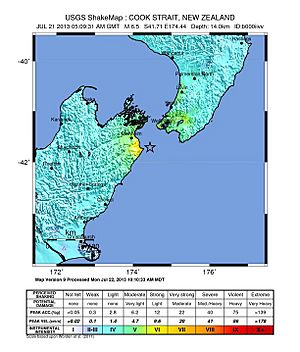2013 Seddon earthquake facts for kids
| UTC time | 2013-07-21 05:09:31 |
|---|---|
| ISC event | 603306074 |
| USGS-ANSS | ComCat |
| Local date | 21 July 2013 |
| Local time | 5:09:30 pm NZST |
| Magnitude | 6.5 Mww |
| Depth | 13 kilometres (8 mi) |
| Epicenter | 41°37′S 174°20′E / 41.61°S 174.33°E |
| Areas affected | New Zealand |
| Tsunami | None |
| Casualties | 4 people injured |
The 2013 Seddon earthquake was a strong earthquake that hit New Zealand. It measured 6.5 on the moment magnitude scale. The earthquake happened in the Cook Strait, which is a body of water between New Zealand's North and South Islands. It was about 20 kilometres (12 miles) east of the town of Seddon in the Marlborough area.
The quake struck at 5:09:30 pm on Sunday, 21 July 2013. It was quite shallow, only about 13 kilometres (8 miles) deep. This earthquake caused some damage in the Marlborough area and in Wellington, New Zealand's capital city. Wellington is about 55 kilometres (34 miles) north of where the earthquake started. Luckily, only minor injuries were reported. This earthquake is seen as the first of two major quakes that happened close together. The second one occurred on 16 August 2013.
Contents
What Happened During the Seddon Earthquake?
The 2013 Seddon earthquake was a powerful event. It was measured by different science groups. Geonet said it was a 6.5 magnitude quake at a depth of 13 kilometres (8 miles). The United States Geological Survey (USGS) also measured it at 6.5 magnitude, but at a slightly deeper 17 kilometres (11 miles).
The earthquake caused buildings to shake and things to fall. It lasted for about 20 seconds. This quake is known as part of an "earthquake doublet." This means two large earthquakes happened in the same area, close in time.
Smaller Quakes Before: Foreshocks
Before the main Seddon earthquake, there were several smaller earthquakes. These are called foreshocks. They happen in the same area before a larger quake. The biggest foreshock measured 5.7 magnitude.
Here are some of the larger foreshocks that happened just before the main earthquake:
| Date (New Zealand Time) | Time (New Zealand Time) | Magnitude | Where it happened | How deep |
|---|---|---|---|---|
| 19 July 2013 | 9:06:39 am | 5.5 | 30 km east of Seddon | 17 km |
| 21 July 2013 | 7:17:10 am | 5.9 | 30 km east of Seddon | 20 km |
Smaller Quakes After: Aftershocks
After the main Seddon earthquake, many smaller earthquakes followed. These are called aftershocks. They happen as the Earth's crust adjusts after a big quake. The largest aftershock measured 5.4 magnitude.
Here are some of the larger aftershocks that happened after the main earthquake:
| Date (New Zealand Time) | Time (New Zealand Time) | Magnitude | Where it happened | How deep |
|---|---|---|---|---|
| 21 July 2013 | 5:09:30 pm | 6.5 | 25 km east of Seddon | 13 km |
| 21 July 2013 | 5:13:50 pm | 5.3 | 30 km east of Seddon | 13 km |
| 29 July 2013 | 1:07:14 am | 5.4 | 20 km east of Seddon | 12 km |
| 2 August 2013 | 12:56:13 am | 5.2 | 20 km east of Seddon | 6 km |
What Damage Did the Earthquake Cause?
The Seddon earthquake caused different levels of damage. In Wellington, the capital city, about 35 buildings in the main business area were damaged. Glass from broken windows fell onto busy streets like Lambton Quay, Featherston Street, and Willis Street.
Damage also happened in other towns in the North Island. These included Paraparaumu, Wainuiomata, Porirua, and the Hutt Valley.
Emergency offices in the Wellington Region were opened on the evening of 21 July. This was to help people and check for damage. The next day, parts of Wellington's city centre were closed. This allowed experts to check buildings for damage and make sure they were safe.
Four people were injured during the earthquake. The shaking blew out windows, cracked concrete, and made buildings sway.



